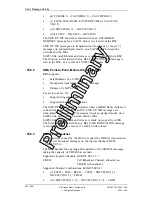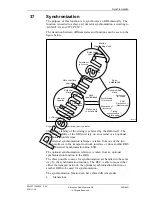
Synchronization
In this mode the RBS uses an incoming PCM-reference or the
optional reference as synchronization reference. The RBS is not
synchronized with any other RBS.
•
Master
In this mode the RBS uses an incoming PCM-reference or the
optional reference as synchronization reference. The generated
timing is also distributed to other RBSes in the RBS cluster via
the ESB.
•
Slave
In this mode the RBS uses another RBS as synchronization
reference. The RBS is synchronized with another RBS, configured
as Master, in the RBS cluster via the ESB.
The mode is set by BSC. Default mode is internally set to Stand-alone.
The Master and Slave modes are used to synchronize RBSes within an
RBS cluster with each other. The different RBSes within the RBS
cluster work together according to the master and slave logic, see the
figure below. One of the RBSes is selected as master by the BSC, and
the other RBSes in the RBS cluster are configured as slaves. The master
RBS synchronizes towards the PCM-reference or the optional reference.
The slave RBS(es) synchronizes towards the master RBS via the ESB.
Master RBS
P005515A
RBS
Slave RBS(s)
ESB
RBS
RBS
Figure 135
Master slave logic of RBSes
37.1
References
/GSM 05.10/
GSM TS 05.10 revision 4.3.0
/JTC PCS/
JTC(AIR) 940904–231R4 Technical
Specification of PCS 1900 by the PCS
1900 Joint Technical Committee
/G.823/
CCITT G.823, White Book
Whenever a reference is made to a function described in another chapter,
please refer to the table of contents to find the appropriate chapter.
37.2
Concepts
Locking
The process of acquiring a phase lock to
the reference
310 (485)
EN/LZT 720 0008
P2A
2001-11-28
© Ericsson Radio Systems AB
— All Rights Reserved —
P
re
li
m
in
a
ry
Содержание RBS 2106
Страница 2: ...P r e l i m i n a r y ...
















































